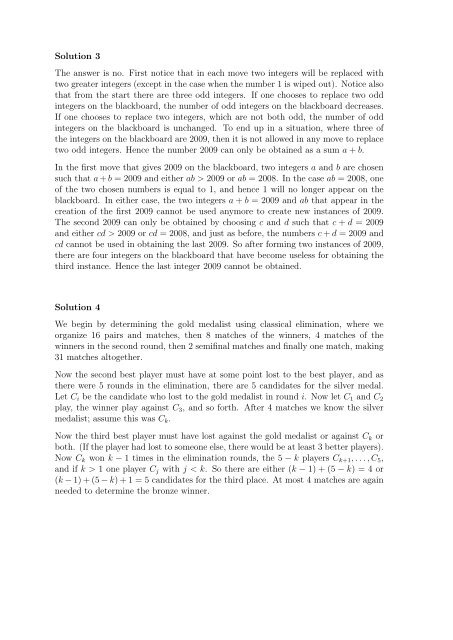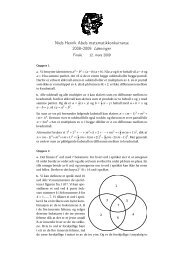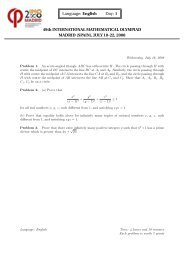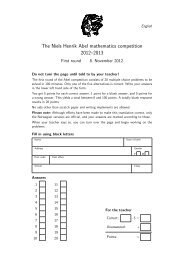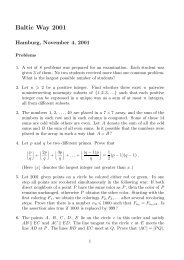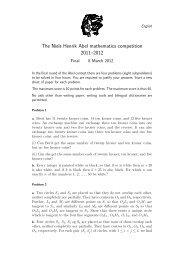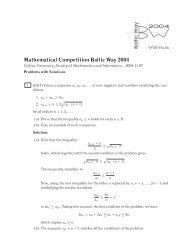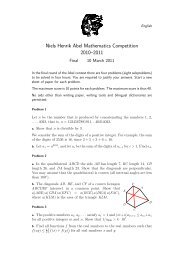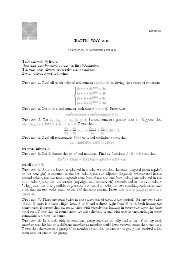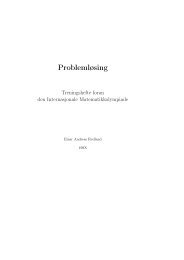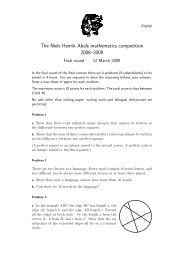The 23rd Nordic Mathematical Contest - Georg Mohr-Konkurrencen
The 23rd Nordic Mathematical Contest - Georg Mohr-Konkurrencen
The 23rd Nordic Mathematical Contest - Georg Mohr-Konkurrencen
- No tags were found...
Create successful ePaper yourself
Turn your PDF publications into a flip-book with our unique Google optimized e-Paper software.
Solution 3<strong>The</strong> answer is no. First notice that in each move two integers will be replaced withtwo greater integers (except in the case when the number 1 is wiped out). Notice alsothat from the start there are three odd integers. If one chooses to replace two oddintegers on the blackboard, the number of odd integers on the blackboard decreases.If one chooses to replace two integers, which are not both odd, the number of oddintegers on the blackboard is unchanged. To end up in a situation, where three ofthe integers on the blackboard are 2009, then it is not allowed in any move to replacetwo odd integers. Hence the number 2009 can only be obtained as a sum a + b.In the first move that gives 2009 on the blackboard, two integers a and b are chosensuch that a + b = 2009 and either ab > 2009 or ab = 2008. In the case ab = 2008, oneof the two chosen numbers is equal to 1, and hence 1 will no longer appear on theblackboard. In either case, the two integers a + b = 2009 and ab that appear in thecreation of the first 2009 cannot be used anymore to create new instances of 2009.<strong>The</strong> second 2009 can only be obtained by choosing c and d such that c + d = 2009and either cd > 2009 or cd = 2008, and just as before, the numbers c + d = 2009 andcd cannot be used in obtaining the last 2009. So after forming two instances of 2009,there are four integers on the blackboard that have become useless for obtaining thethird instance. Hence the last integer 2009 cannot be obtained.Solution 4We begin by determining the gold medalist using classical elimination, where weorganize 16 pairs and matches, then 8 matches of the winners, 4 matches of thewinners in the second round, then 2 semifinal matches and finally one match, making31 matches altogether.Now the second best player must have at some point lost to the best player, and asthere were 5 rounds in the elimination, there are 5 candidates for the silver medal.Let C i be the candidate who lost to the gold medalist in round i. Now let C 1 and C 2play, the winner play against C 3 , and so forth. After 4 matches we know the silvermedalist; assume this was C k .Now the third best player must have lost against the gold medalist or against C k orboth. (If the player had lost to someone else, there would be at least 3 better players).Now C k won k − 1 times in the elimination rounds, the 5 − k players C k+1 , . . . , C 5 ,and if k > 1 one player C j with j < k. So there are either (k − 1) + (5 − k) = 4 or(k − 1) + (5 − k) + 1 = 5 candidates for the third place. At most 4 matches are againneeded to determine the bronze winner.


